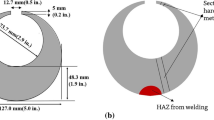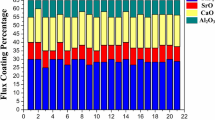Abstract
Processes affecting the cold resistance of wall ceramics are described within the irreversibility, nonequilibrium, and synergism approach. The significance of the size and shape of the pores, the chemical composition of the pore surfaces, their effect on the shape and mechanical properties of ice formations appearing in different conditions of impregnation and freezing-thawing are considered. It is shown that the conventional methods of testing for cold resistance are inadequate for imitating a variety of operational conditions.
Similar content being viewed by others
References
V. S. Bakunov and A. V. Belyakov, “The problem of analyzing the structure of ceramics,”Izv. Ross. Akad. Nauk. Ser. Neorhanich. Mater.,31(12), 1–6 (1995).
G. Nicolis and I. Prigogine,The Concept of the Composite: Introduction [Russian translation], Mir, Moscow (1990).
I. Prigozhin and I. Steangers,Time, Chaos, Quantum [Russian translation], Progress Publishers, Moscow (1994).
V. S. Ivanova, A. S. Balankin, I. Zh. Bunin, et al.,Synergism and Fractals in Materials Science [in Russian], Nauka, Moscow (1994).
H. Hagen,Synergism, Springer, Heildelberg (1978).
E. S. Lukin and N. T. Andrianov,Technical Analysis and Control of Ceramics Production [in Russian], Stroiizdat, Moscow (1986).
R. V. Machulaitis, “Technological and methodological aspects in determining cold resistance of wall ceramics,”Stroit. Mater., No. 6, 23–24 (1989).
M. Zygadlo and Z. Piasta, “Indirect assessment of cold durability of ceramics,”Ind. Ceram.,8(3), 129–133 (1988).
A. S. Berkman and I. G. Mel'nikova, “Effect of pore structure on the cold resistance of brick,”Stroit. Mater., No. 4, 34–37 (1960).
A. S. Sadunas, R. V. machulaitis, and A. Yu. Kaminskas, “The problem of frost durability of ceramic brick and real ways of its solution,”Stroit. Mater., No. 9, 14–16 (1984).
V. N. Burmistrov, E. P. Usanova, and V. N. Orlovskaya, “Endurance of wall ceramic brick from coal-concentration waster,”Stroit. Mater., No. 8, 18–19 (1989).
A. G. Korenyuk and L. S. Dumanova, “Disruption of ceramic brick by segregation ice,”Stroit. Mater., No. 3, 24–26 (1993).
D. I. Shvaika,A Reference Book of Wall Ceramics Producers [in Russian], Bydivelnik, Kiev (1990).
S. Zh. Saibulatov and M. Kulbekov, “Factors providing for high cold resistance of cinder wall ceramics,”Stroit. Mater. No. 9, 15 (1983).
K. K. Strelov,Structure and Properties of Refractories [in Russian], Metallurgiya, Moscow (1972).
N. N. Kruglitskii, B. V. Lobanov, and V. V. Kuz'movich, “Role of mechanical activation of clay in structure formation of ceramic materials,”Izv. Akad. Nauk SSSR. Ser. Neorganich. Mater.,22(11), 1886–1889 (1986).
Author information
Authors and Affiliations
Additional information
Translated from Steklo i Keramika, No. 10, pp. 13–16, October, 1996.
Rights and permissions
About this article
Cite this article
Belyakov, A.V., Zakharov, A.I. Theoretical prerequisites for creating cold-resistant ceramics. Glass Ceram 53, 298–300 (1996). https://doi.org/10.1007/BF01130794
Issue Date:
DOI: https://doi.org/10.1007/BF01130794




